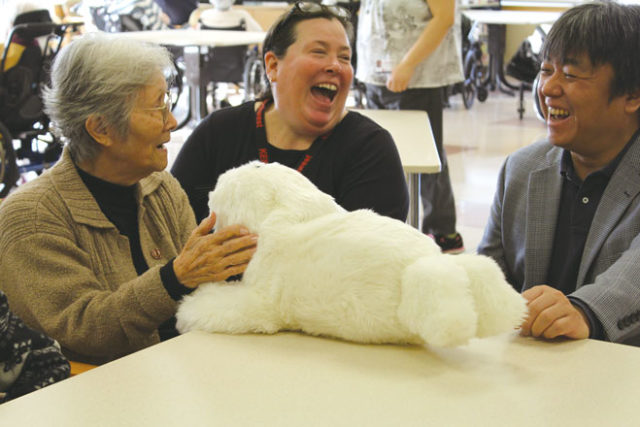
By Shihou Sasaki
The North American Post
Japanese therapeutic robots have been a supportive tool for local senior care. Everyday residents at the Seattle Keiro Rehabilitation and Care Center enjoy interacting with the white “fur” robot called Paro.
On the morning of Nov. 10, residents interacted with the Paro for a few minutes each. They touched, petted, hugged, talked or kissed it. Each resident had a different way to communicate and play. The robot responded to each action, and all faces turned to smile very quickly. All moments were indeed therapeutic.
The Paro Robot was invented in Japan by Takanori Shibata of the National Institute of Advanced Industrial Science and Technology as a substitute therapy tool for animal therapy. The robot looks like a baby harp seal and is accepted by many animal lovers.
The robot has been used since 2003, mainly in Japan and Europe. Now it has been upgraded as the ninth generation, having five kinds of sensors –tactile, light, audition, temperature and postures–which can perceive people and their environment.
“It is pleasure to see how residents enjoy playing with Paro,” said Shibata, who visited the Rehabilitation and Care Center on Nov. 10. “There are English speakers, Japanese speakers or others, but I am happy to see that they’re so fond of Paro.”
According to Shibata, the Paro also helps the residents’ daily cycle. Having activities in day time, can avoid taking an unnecessary nap, and get a good night’s sleep.
He added that he was happy to see the Japanese technology entertaining residents at a Nikkei-related facility. He later visited a veteran’s care facility in DuPont, Wash.
Shibata said that the Paro can provide therapeutic support in many ways. He said that other versions of Paro can be designed to help those who need to develop their social skills.
The Paro Robot, which actually costs $6,000, was not a cheap addition, for Keiro Northwest. But the local non-profit senior care organization successfully raised the funds in its annual golf tournament a few years ago. Soon, two Paros joined the therapy team in the facility.
Results were immediate based on reactions from residents, especially those who were suffering from dementia. The Keiro staff also enjoyed the daily activities with Paro.
“I am so amazed,” said Suzanne Gollhofer, activities manager of Keiro Northwest. “A lot of residents who are not happy, then we put the Paro in front of them and make them light up.
“That makes the world different. It is a quick and easy activity because everybody enjoys.”






